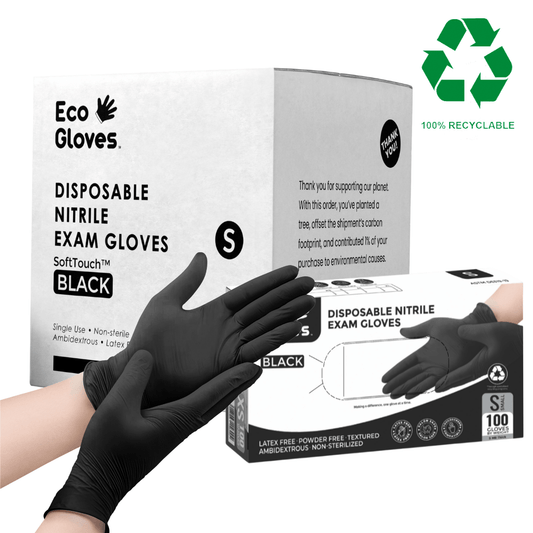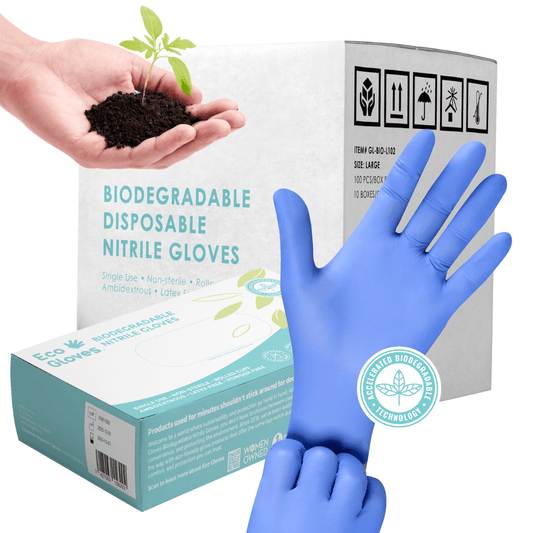Dental Gloves: The Complete Guide to Types, Materials, and Best Practices
Eco GlovesTopics Covered
- Why Dental Gloves Are Essential in Modern Dentistry
- Types of Dental Gloves: Choosing the Right Option for Different Procedures
- Dental Glove Materials: Advantages and Considerations
- Understanding Glove Thickness: Why It Matters
- Selecting the Right Dental Gloves: Factors to Consider
- Top Glove Features Dental Professionals Prioritize
- Best Practices for Dental Glove Usage
- Common Challenges with Dental Gloves and Solutions
- Regulatory Standards and Compliance
- The Future of Dental Gloves
- Key Takeaways: Choosing the Best Dental Exam Disposable Gloves
- Frequently Asked Questions About Dental Gloves
Why Dental Gloves Are Essential in Modern Dentistry
The importance of proper hand protection in dental settings cannot be overstated. Dental professionals work in an environment where exposure to saliva, blood, and other potentially infectious materials is common. According to the American Dental Association (ADA), high-quality dental gloves create an essential barrier that:
- Prevents the transmission of pathogens between patients and dental staff
- Reduces the risk of healthcare-associated infections
- Complies with regulatory standards established by organizations like OSHA and the CDC
- Protects hands from harsh chemicals used in dental procedures
- Maintains sterile conditions during invasive procedures
According to the Centers for Disease Control and Prevention (CDC), proper glove usage is a fundamental component of standard precautions in healthcare settings, including dental practices.

Types of Dental Gloves: Choosing the Right Option for Different Procedures
Examination Gloves
Examination gloves are the most commonly used type in dental practices. These non-sterile gloves are designed for routine dental examinations and non-surgical procedures. Key characteristics include:
- Single-use
- Available in various materials (nitrile, latex, vinyl)
- Come in ambidextrous shapes to fit either hand
- Typically feature textured fingertips for enhanced grip
- Available in multiple sizes for proper fit
Surgical Gloves
Dental surgical gloves are specifically designed for surgical procedures where sterility is paramount. These gloves differ from examination gloves in several important ways:
- Sterile packaging
- Hand-specific (left and right) for improved fit and dexterity
- Longer cuffs to provide better wrist coverage
- Thinner material for enhanced tactile sensitivity
- More precise sizing options
- Subjected to more rigorous quality control testing
Utility Gloves
Heavy-duty utility gloves serve a different purpose in dental practices. These could be reusable or disposable, but they should be puncture-resistant since they are used for:
- Cleaning instruments
- Surface disinfection
- Handling hazardous chemicals
- Laboratory work
- Equipment maintenance
Dental Glove Materials: Advantages and Considerations
Nitrile Dental Gloves
Nitrile gloves have become increasingly popular in dental settings, particularly as an alternative to latex. These synthetic gloves offer several advantages:
- Highly resistant to punctures and tears
- Free from latex proteins that can cause allergic reactions
- Chemical resistance against many dental materials and disinfectants
- Excellent sensation and dexterity
- Available in various colors for visual identification
- Longer shelf life compared to latex gloves
Studies published in the National Library of Medicine show that nitrile gloves provide up to three times more puncture resistance than latex alternatives, making them ideal for procedures involving sharp instruments.
Latex Dental Gloves
Natural rubber latex gloves have historically been the standard in dentistry due to their excellent elasticity and comfort. Benefits include:
- Superior elasticity and form-fitting properties
- Excellent tactile sensitivity
- High level of comfort during extended wear
- Biodegradable material
- Generally lower cost than some alternatives
However, latex allergies remain a significant concern, affecting approximately 8-17% of healthcare workers and 1-6% of the general population according to research published by the National Institute for Occupational Safety and Health (NIOSH).
Vinyl Dental Gloves
Vinyl gloves provide another latex-free alternative, though they're typically used for brief, low-risk procedures. Their characteristics include:
- Very low allergy risk
- Cost-effectiveness
- Adequate protection for short, non-invasive procedures
- Less elasticity and durability than nitrile or latex
- Reduced chemical resistance
Neoprene Dental Gloves
Neoprene offers another synthetic alternative that combines many of the beneficial properties of latex without the allergen concerns:
- Similar elasticity and fit to latex
- Excellent chemical resistance
- Suitable for patients and practitioners with latex allergies
- Higher cost than other options
- Increasing availability as technology improves
Understanding Glove Thickness: Why It Matters
Glove thickness plays a critical role in balancing dexterity with protection in dental settings. Measured in mils (1 mil = 0.001 inch), disposable dental gloves typically range between 3 to 6 mils thick.
For routine exams and detailed work that requires tactile precision, thinner gloves around 3–4 mils are often preferred, as they offer enhanced sensitivity and flexibility. On the other hand, thicker gloves—5–6 mils—provide better durability and puncture resistance, making them a solid choice for procedures involving sharp instruments, extended wear, or higher exposure to bodily fluids and chemicals.
Dental practices may benefit from stocking a range of thicknesses to accommodate various procedures and practitioner preferences.
Selecting the Right Dental Gloves: Factors to Consider
When choosing dental gloves for your practice, several factors should influence your decision:
-
Allergen Considerations: With latex allergies affecting a significant portion of the population, many practices are transitioning to latex-free environments.
-
Procedure Requirements: Different procedures demand different levels of protection, dexterity, and tactile sensitivity.
-
Comfort and Fit: Properly fitting gloves reduce hand fatigue and increase compliance with glove-changing protocols.
-
Glove Thickness: Thinner gloves (3–4 mils) offer better tactile sensitivity for precision tasks, while thicker gloves (5–6 mils) provide enhanced durability and puncture resistance—ideal for procedures involving sharp tools or extended wear. Select the thickness based on your preference or work task.
-
Chemical Compatibility: Ensure gloves are resistant to chemicals commonly used in your specific dental procedures.
-
Cost-Effectiveness: While price shouldn't be the primary factor, budget constraints are a reality for many practices.
-
Environmental Impact: Some practices prioritize biodegradable or environmentally friendly options when possible.
Top Glove Features Dental
Professionals Prioritize
| Feature | Reasoning |
|---|---|
| Tactile Sensitivity & Dexterity | Precision is critical in dental procedures, so gloves must allow for fine motor movement and sensitivity, especially for tasks like examinations, cleanings, and surgical work. |
| Strength & Puncture Resistance | Gloves should resist tearing or punctures from instruments like scalers or dental picks. Nitrile gloves, particularly in the 4–6 mil range, are often preferred for their durability. |
| Comfort & Fit | Dental professionals wear gloves for long periods, so ergonomic fit and reduced hand fatigue are key. A snug, contoured fit helps with comfort and performance. |
| Latex-Free Composition | To avoid allergic reactions for both patients and staff, many practices opt for nitrile or neoprene gloves over traditional latex. |
| Grip & Texture | Textured fingertips or palm areas improve grip on tools, especially in wet conditions—essential for maintaining control during procedures. |
| Thickness Balance | A middle ground of 4–5 mils is often ideal—thick enough to protect, but thin enough to retain touch sensitivity. |
| Powder-Free | Most dental gloves are powder-free to avoid contamination and reduce risk of respiratory or skin irritation. |
Best Practices for Dental Glove Usage
To maximize protection and comply with infection control standards, dental professionals should adhere to these best practices:
Proper Hand Hygiene
- Always wash hands thoroughly before donning gloves
- Use alcohol-based hand sanitizer when soap and water aren't available
- Ensure hands are completely dry before putting on gloves
- Perform hand hygiene immediately after removing gloves
Glove Changing Protocols
- Change gloves between each patient
- Replace gloves that become torn, punctured, or contaminated
- Never wash or reuse disposable gloves
- Change gloves when switching between different procedures on the same patient
- Avoid touching environmental surfaces while wearing contaminated gloves
Double Gloving Considerations
For procedures with high risk of glove perforation or involving sharp instruments, double gloving may provide additional protection:
- Reduces the risk of exposure in case of outer glove perforation
- Often implemented with different colored gloves to make tears more visible
- May slightly reduce tactile sensitivity

Common Challenges with Dental Gloves and Solutions
Latex Allergies
The increasing prevalence of latex allergies presents challenges for dental practices. Solutions include:
- Transitioning to completely latex-free environments
- Maintaining clear patient records regarding latex allergies
- Providing alternative glove options for staff with sensitivities
- Educating staff about recognizing signs of latex allergy
Hand Dermatitis
Frequent glove use can lead to irritant contact dermatitis among dental professionals. Preventive strategies include:
- Using glove liners for susceptible individuals
- Applying moisturizer after hand washing and at the end of the work day
- Selecting powder-free gloves to reduce irritation
- Rotating between different glove materials when possible
Regulatory Standards and Compliance
Dental practices must comply with various regulatory standards regarding glove usage:
- OSHA: Mandates appropriate gloves as part of PPE requirements
- FDA: Regulates dental gloves as medical devices
- ASTM International: Establishes performance standards for medical gloves
-
ADA: Provides guidelines for infection control in dental settings
The Future of Dental Gloves
Innovation continues in dental glove technology, with several emerging trends:
- Antimicrobial Gloves: Embedded with agents that kill bacteria on contact
- Smart Gloves: With sensors that monitor usage time or detect breaches
- Eco-Friendly Options: Biodegradable alternatives to traditional synthetic gloves
-
Enhanced Comfort Features: Reduced thickness without compromising protection
Final Thoughts
Dental gloves represent a crucial component of infection control in modern dentistry. By understanding the various types, materials, and best practices associated with dental gloves, practitioners can make informed decisions that protect both themselves and their patients. As technology advances, we can expect even more effective and comfortable options to emerge, further enhancing safety in dental settings.
Whether you're establishing a new practice or reviewing your current PPE protocols, thoughtful consideration of your dental glove selection can significantly impact both safety outcomes and practitioner comfort. By following the guidelines outlined in this article, dental professionals can ensure they're providing the highest standard of protection while maintaining the dexterity and sensitivity needed for precise dental procedures.
Need Dental Gloves That Deliver Comfort and Protection?
From daily exams to complex procedures, having the right gloves can make all the difference. Explore our full line of premium nitrile, latex-free, and exam-grade gloves designed for dental professionals. Find the fit, feel, and function you need at EcoGloves.co.
Key Takeaways: Choosing the Best Dental Exam Disposable Gloves
- Nitrile Offers Superior Protection: Strong, soft, and resistant to chemicals, nitrile gloves are ideal for most dental procedures, especially for durability and comfort.
- Latex Provides Precision Fit: Latex gloves offer excellent elasticity and tactile sensitivity, but should only be used when neither clinician nor patient has latex allergies.
- Vinyl and Poly Gloves for Light Tasks: Vinyl is a cost-effective choice for short procedures, while poly gloves (or compostable alternatives) work well as over gloves for quick changes.
- Over gloves Reduce Contamination Waste: Using PE or compostable over gloves on top of exam gloves prevents contamination and reduces waste from frequent glove changes.
- Eco-Friendly Options Available: Compostable biopolymer gloves function like traditional PE gloves but break down naturally, reducing landfill waste and lowering carbon emissions.
-
Quality Matters: High-quality dental gloves resist tears, fit ergonomically, and provide textured grip for wet conditions, ensuring comfort and safety during procedures.
👉 From nitrile exam gloves to compostable over gloves, Eco Gloves provides dental professionals with reliable, sustainable solutions that protect patients, staff, and the planet.
Frequently Asked Questions About Dental Gloves
-
What are the best gloves for dental use?
Nitrile gloves are often considered the best choice for dental use due to their puncture resistance, comfort, and latex-free properties. However, latex and neoprene gloves are also used depending on practitioner preference and patient sensitivities.
-
What is the ideal thickness for dental gloves, and why does it matter?
Dental gloves typically range from 3 to 6 mils in thickness. Thinner gloves (around 3–4 mils) offer greater tactile sensitivity, which is ideal for precision work like examinations and non-invasive procedures. Thicker gloves (5–6 mils) provide added durability and puncture resistance, making them better suited for tasks involving sharp instruments or longer wear times. The ideal thickness depends on balancing dexterity with protection based on the procedure.
-
Are nitrile gloves better than latex for dentistry?
Yes, many dental professionals prefer nitrile gloves because they are more resistant to punctures and chemicals, and they reduce the risk of allergic reactions commonly associated with latex.
-
What size dental gloves should I use?
Dental gloves come in sizes ranging from extra-small to extra-large. It's important to choose a snug fit that allows for dexterity without being too tight or loose.
-
Can dental gloves be used for other tasks like cleaning or handling instruments?
While exam and surgical gloves are designed for patient care, heavy-duty utility gloves are better suited for cleaning, disinfection, and instrument handling due to their durability and chemical resistance.
-
Are there dental gloves for people with sensitive skin or allergies?
Yes, latex-free options like nitrile, vinyl, and neoprene are ideal for individuals with latex allergies or sensitive skin. Look for powder-free and hypoallergenic labels.
-
How often should dental gloves be changed?
Dental gloves should be changed between each patient, whenever they become contaminated or damaged, and when switching between different procedures on the same patient.
-
Are dental gloves regulated?
Yes, dental gloves are regulated by the FDA, OSHA, and ASTM to ensure they meet safety and performance standards for use in medical and dental settings.

















